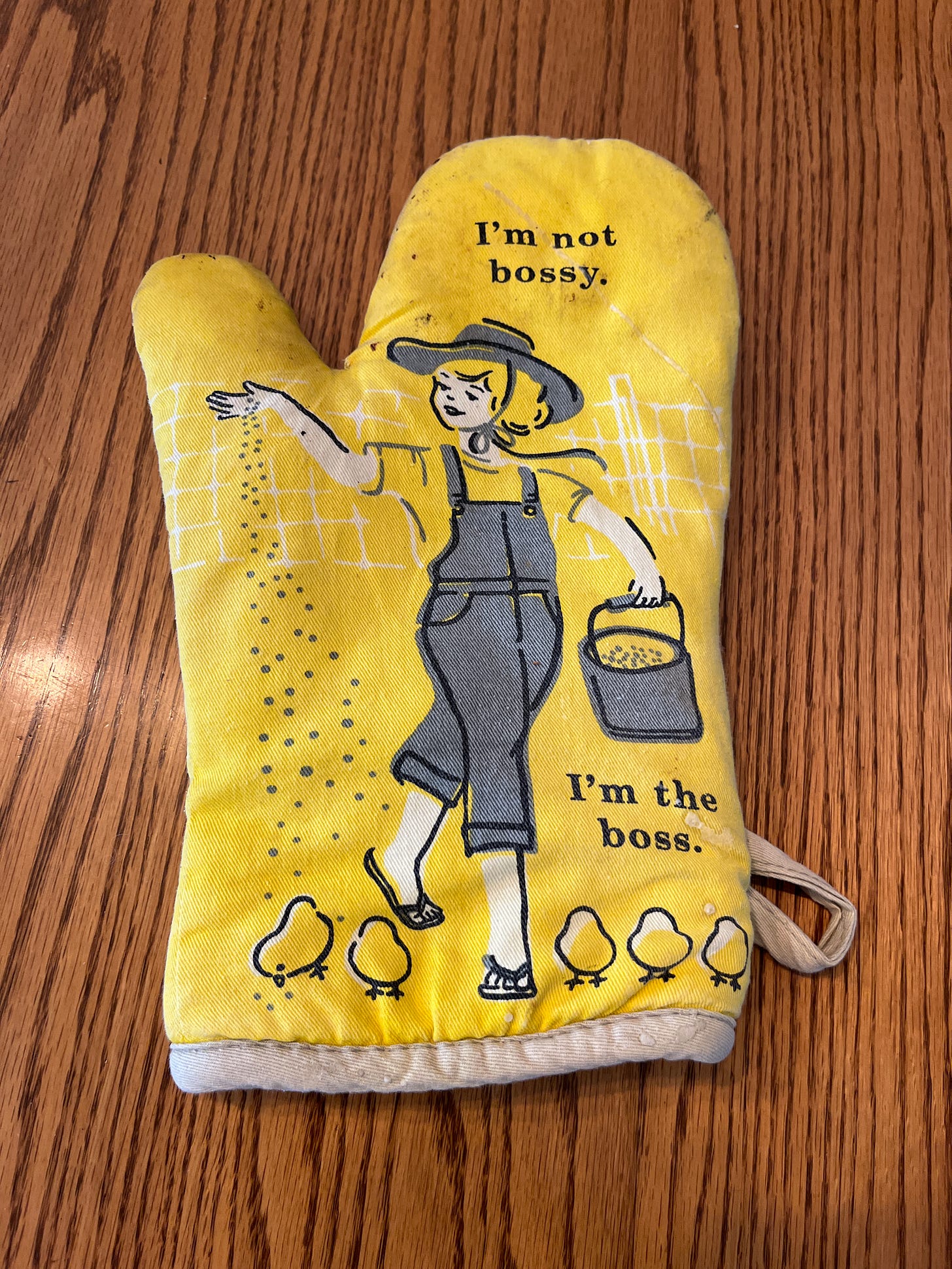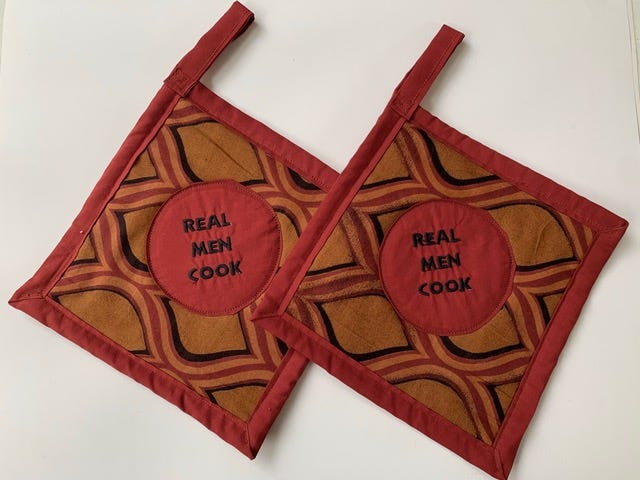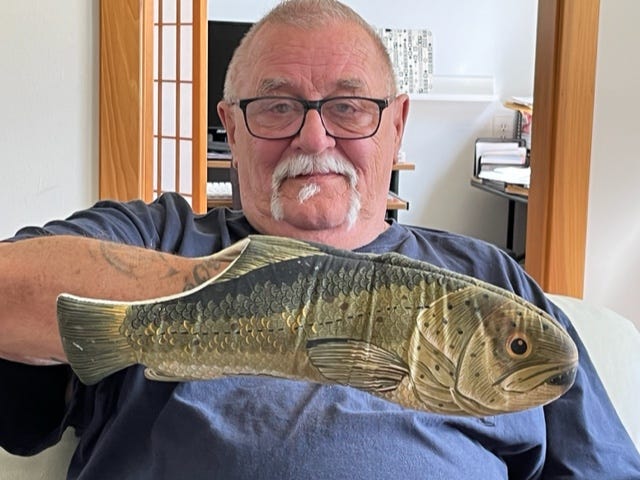Bristling at the idea of banned books? Of muzzled classrooms? Don’t despair. Go to your kitchen and pick up a potholder. Yes, that same piece of cloth you use to pull a roast out of the oven. That utilitarian work of art will reveal all you need to know about our historical period, and our issues of gender, race and sexuality.
This year on my AgArts from Horse & Buggy Land podcast, I announced a contest for favorite potholders. Entries flowed in with commentaries from their owners. There were potholders that documented the pandemic, and those tied to family, farming and food. They were feminist potholders. And grilling mitts in the shape of fish to take on camping trips.
Pictures of religious potholders were sent in on the same day as potholder puppets of dragons and devils. Rip Russell of Iowa City, IA, remembered making potholders as a child with his grandmother on a little toy loom. In retirement, he took up the craft again.
Other potholders had been Christmas gifts passed down from one generation to another. Mary Nevel, from Murfreesboro, TN, entered two well-worn, well-loved potholders that her mother had embroidered years before.
“This mitt was a gift from one of my sisters,” Aleta Porcella in Iowa City, said of a yellow piece of quilted cloth with a picture of a woman farmer, scattering feed to her chickens. Near the top of the mitt were the words: I’m not bossy. Near the bottom: I’m the boss.
“One of my coping mechanisms during Covid was to make potholders,” Jean Graham, from Austin, TX, said. “I used re-cycled materials I already had around the house. Real Men Cook was made out of fabric I got in West Africa more than 30 years ago.”
Susan Strawn, Ph.D. in Textiles and Clothing from Iowa State University, judged the contest. With a potholder collection of her own that spans over a century, she provided insights on our podcast (Episode #36) interview:
For the most part, you’re right, people just used the corner of an apron or something like that. And when you think about it, they used to cook on a hearth with a pot that swung over the fire. So, they used tools to access their food. They didn’t need potholders that much. But that said, I found that there are museums with potholders that are quite old. The Smithsonian National History Museum has a potholder that dates back to 1835.
Then there are the potholders that have messages from the Civil War era. They read: ANY HOLDER BUT A SLAVEHOLDER. And they were made by women in the North and sold to support the soldiers.
But really, potholders get started as folklore around the turn of the twentieth century. Then you start seeing these little muslin potholders with sayings on them like: HOT POT, I FEEL YOU NOT. Potholders follow along as people’s lives change. And as demographics and marketing changes.
After World War I, when more people are moving into smaller houses—bungalows—and they have fewer servants, the woman of the house is in the kitchen doing her own cooking. The potholders become more colorful and become décor. What I find then, I have dozens of potholders in my collection that are human faces. It’s almost like the cook needed some company in the kitchen.
Getting into the 1930s, women would cut up fabrics and the potholders looked like quilts. Then, of course, the looper potholders go back to the industrial manufacture of socks and stockings. They would cut the tops off of them and there would be little knit loops. Those were going to waste until somebody figured out that they could package them with a portable loom and they could sell them to these Depression era housewives. They would weave them into these looper potholders. Then by the 1950s, the loom was a child’s toy.
Strawn finds that potholders reflect history, culture and society. For example, until current times, the only genders represented on potholders were male and female. Often, potholders represented immigration with Swedish flags or a little Dutch girl. The images of Asians or African-Americans, though, were very derogatory. Today we cringe at them but when they were created, people found them “cute.” Henry Lewis Gates Jr. wrote how these memorabilia potholders suggested African-American’s place was “in the kitchen.”
Find more potholders and their suggestions by watching the online exhibits of both Strawn’s collection and the Buggy Land contestant submissions. And listen to the full Susan Strawn interview on Episode #36 of AgArts from Horse & Buggy Land. Read the first chapter of Strawn’s memoir about knitting on The Blazing Star Journal. www.agarts.org.
The exhibits were curated by Susan Strawn and the videos produced by Janine Calsbeek. I am part of the Iowa Writers Collaborative. Please follow them on Substack.








Oh, wow! You had me with this early line: "...I announced a contest for favorite potholders." In the long history of column writing and attempted reader engagement, this has to be one of the all-time best ideas. It's kind of like the name of the relatively new column by our pal, "Julie Gammack's Iowa Potluck." As a reader when you encounter such things, you just can't turn away. Keep 'em coming, Mary. It's going to be fun being on the same team with you.
Thank you, Mary. Your thoughts about pot holders spurred many thoughts about pot holders in my kitchen, my mom's kitchen, my aunt's kitchens, my sister's (and brother's) kitchens. Your writing is warm and cozy. Thank you!